Chapter 13
Photographing and Recording the World Around You
Every iPhone since 3G offers two cameras—one in the front and one in the rear. These cameras represent two of the most significant features of the iPhone: the ability to take photos and record high-definition video and the ability to place FaceTime video calls. Each generation represents a major improvement in technology over the hardware that preceded it, and each camera upgrade has provided a significant advancement in technology.
With the iPhone 4S, the primary iPhone camera on the reverse of the unit has gone from excellent to amazing. With 8 megapixels and improved optics, Apple isn’t far off when it states in its marketing text that this might be the best camera ever on a mobile phone.
The 8-megapixel camera provides 60 percent more pixels than the iPhone 4 ever did, and that camera was engineered with amazing light collection features. Its quick responsiveness and improved optics mean you can capture pictures better and more beautifully than ever before. You can catch images of water as it splashes and leaves as they twirl down from the trees, and you can do all this without blurring and fuzziness. With its incredible dynamic range, you can capture pictures in candlelight and full daylight.
The Camera Hardware
The iPhone features two cameras—one front and one rear. The lower-resolution front camera is meant for video conferencing and social use. The high-end rear camera helps you snap photos and record high-definition video for your personal memories.
Front Camera
The front camera is located at the top of the iPhone, directly in the center of the iPhone’s upper bezel. If you shine a light directly on your iPhone, you can make out a tiny opaque dot about the size of a pencil tip. Behind this dot lies the front-facing camera.
This camera opens up the world of FaceTime video calls (see Chapter 14), although you can also take photos and record video with it. It’s also a great tool for taking self-snapshots for profile pictures for social networking sites. No more shooting your picture in a bathroom mirror or turning the camera around and hoping you get yourself in the shot! With the front camera, you can see and compose the shot as you take it.
The front-facing camera isn’t as powerful as the rear camera. It doesn’t record high-definition (HD) video. High-definition video is defined as video that has at least 720 lines of resolution. The more lines of resolution, the sharper the picture. Although the front camera can record video, its resolution is limited to standard-definition (SD) VGA-style video at up to 30 frames per second. SD video has a resolution of 640×480.
Why didn’t Apple use an HD camera in the front? Well, it would be unnecessary. The front camera was designed for video calling and playing around, not for recording video. The image quality while video calling on a small device like the iPhone is more than good enough using an SD camera.
Rear Camera
The rear camera is the primary one you will be using to take photos and record video. If you flip your iPhone over, you’ll see the rear camera in the top-left corner of the device.
The iPhone 4S rear camera will record videos in 1080p HD resolution at 30 frames a second; that’s HDTV-quality video. Its still-camera capabilities are far better than the front-facing camera; the rear-facing camera can take 8-megapixel photographs, a massive improvement over the previous iPhone 4 model.
This high-quality camera means that the iPhone 4S is ready to snap good-quality pictures suitable for framing. You can bring your iPhone on vacation for once-in-a-lifetime nature photography, to social events to capture moments from your wedding, or even to your baby’s birth. The iPhone 4S is completely up to the task.
NOTE: What’s the p stand for in 720p? you ask. P means progressive. When HD video is displayed on a screen, it shows either all 720 lines of resolution at a time or just half of them. If it shows only half of them, this is known as interlace video and is denoted with an i. Simply put, progressive video generally looks sharper because it shows you all the data (or lines of resolution) in a single frame at a time, and interlace shows you only half the data at a time (followed quickly by the other half). Interlace video used to be the norm when bandwidth issues were more of a factor, but as bandwidth increased, progressive video slowly took over.
Real-World Use
In real-world use, the iPhone 4S does a superior job at recording HD video and still photographs. The iPhone uses a light-sensitive sensor, which can be used in a wide range of lighting situations. This sensor allows for the best image quality the hardware can record. Because of this sensor, even in low-light conditions, the quality is still very good.
Navigating the Camera App
To launch the Camera application, tap the Camera icon. It looks like a gray button with a camera lens on it (see Figure 13–1). The camera can be used in either portrait or landscape mode. Simply rotate your iPhone to switch between the two orientations.

Figure 13–1. The Camera app
Figure 13–2 shows the standard layout of the Camera app. With the exception of the Switch Camera and Options buttons at the top of the screen, all the camera controls reside in the gray bar at the bottom of the screen in portrait orientation. When you rotate into landscape orientation, the Switch Camera and Options buttons remain at the top of the screen, but the camera control bar shifts to the left (or right) of the screen. The icons on the control bar simply rotate to match your iPhone’s orientation.

Figure 13–2. The camera controls
The camera controls are as follows:
Switch between still and video camera mode: Tap the slider that lies below icons of a still and video camera in the right of the control bar. The camera icon with the slider button below it is the mode the camera is in (in Figure 13–2, the slider is below the still camera, so you know that you are in still-camera mode).
Switch between cameras: Tap the Switch Camera icon in the top right of the screen to switch between the front and rear cameras. The icon looks like a traditional still camera with swirling arrows on either side. You’ll see a 2D animation of the screen flipping between cameras.
Select flash mode: Tap the flash mode toggle at the top left of the screen to choose the flash mode. Options include Auto, On, and Off. In Auto mode, the iPhone detects the light levels. In On mode, the flash is always used when snapping photographs. In Off mode, the flash is disabled.
Options: This button allows you to access the camera gridline overlay that helps you compose images using the classic rule of thirds and the HDR toggle. With High Dynamic Range (HDR), the camera captures three photographs from your one shot, each with a different exposure level. It then combines these shots to create a single photo, capturing the best quality elements from each of the component shots. The iPhone can save both the original image and the HDR-enhanced photo to your camera roll (via an option in Settings
Photos), so you can see the difference that HDR makes.
Shutter button: Tap the oval button with the icon of a traditional still camera in the center of the control bar to take a still photograph. This button changes to an oval button with a red dot in the center when you are in video camera mode. Tap the button to record video. Tap again to stop recording. If you have your finger on the Shutter/Record button but then change your mind about photographing or recording your subject, you can slide your finger off the button and no image will be taken, nor will video begin being recorded.
Access the Camera Roll: Tap the square button on the left of the control bar. The square will be filled with an icon of the last image or video recorded. Once tapped, your Camera Roll will slide up on screen. This is a great feature for reviewing your last photo or video. It saves you a lot of time since you don’t have to leave the Camera app to check out your Camera Roll in the Photos app.
Taking Still Pictures
Taking a still photograph couldn’t be easier. Point your camera at what you want to take a picture of, and tap the shutter button. You can also press the topmost volume button on the side of your iPhone. While in camera mode, the topmost volume button acts as a shutter button. You’ll hear a shutter click sound effect and see a brief animation of a lens’s iris quickly closing and then opening. After that, the still image you just took will jump down into the Camera Roll icon.
NOTE: Some people find that tapping the on-screen shutter button to take a still photo causes their composition to get messed up. A neat trick Apple included to counteract any accidental nudging when you tap the shutter button is this: tap and hold the shutter button and then compose your shot. When you are ready to take the photo, simply remove your finger from the shutter button, and the shot will be recorded.
Autofocus and Exposure
You can set the exposure of the camera by tapping anywhere on the screen. You’ll see a white box with crosshairs quickly appear. The iPhone’s camera reads the exposure setting of the part of the image inside the box and adjusts the image accordingly.

Figure 13–3. Tap the screen to autofocus and set the exposure.
Setting the exposure helps when you are shooting an image of a cloudy sky, for example. If you want the sky to appear other than blinding white, tap the area of the image on your iPhone’s screen, and the exposure will adjust accordingly. When you tap any portion of the image, the camera will also autofocus on the part of the image.
Composing Shots with Gridlines
There’s a tenet in photography called the “rule of thirds,” which was first introduced in Chapter 12. It states that pictures that are split into thirds, with features placed at the one-third mark and/or two-thirds mark, provide better composition than images with more arbitrary placements.
When you place features along the rule-of-thirds lines, especially at the four intersections, you’ll end up with better-composed scenes. You can also use the rule of thirds to sequester items; that is, you can limit the subject of your shot to one-third of the screen—preferably the outer edges—to make for a much more interesting shot. Both sequestering and composition can be helped when you can see a grid on your screen.
With this in mind, Apple built gridlines into the Camera app. To turn on Gridlines, tap the Options button (Figure 13–2) and set Grid to On (Figure 13–4). Gridline will appear on your screen dividing it into nine squares. Tap Done to exit the options menu. To turn off Gridline, go back into options and set Grid to Off. While gridlines appear on your iPhone screen, they will not appear in your photographs. They are provided for composition only.
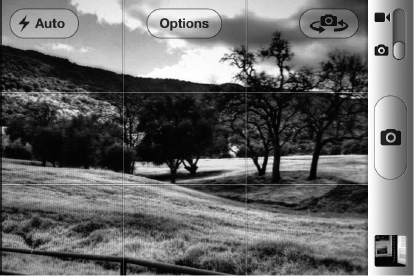
Figure 13–4. Turning on gridlines helps you compose your shots using the rule of thirds.
Pinch to Zoom In and Out
To zoom in or out, simply pinch the screen with two fingers. The zoom slider appears (Figure 13–5). This zoom bar allows you to adjust the digital zoom settings of the photograph; it lets you zoom in and out on your subject. Slide your finger along the bar to zoom in or out. You can also tap the + or − button to zoom in or out in increments or simply continue pinching in or out
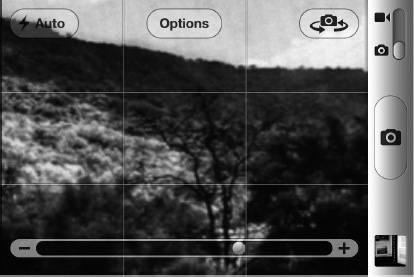
Figure 13–5. The zoom controls appear above the control bar while tapping the screen in still-camera mode.
NOTE: You can zoom in only while in still-camera mode using the rear camera. You cannot zoom using the front-facing camera. There is also no zoom while in video camera mode.
Recording Video
To record video, set the slider in the control bar to video camera mode. The camera’s shutter button will be replaced with a recording button (see Figure 13–6). Tap the record button to begin recording your video. The red dot on the record button will begin to glow, and a time code stamp will appear in the upper right of the screen showing the hours, minutes, and seconds that have elapsed since recording began. To stop recording, tap the record button again. While recording, double-tap the screen to enter the 16:9 aspect ratio.
Just how much video can you record on your iPhone? That depends on the size of your iPhone and how much space you have available. If you have a 32GB iPhone but have only 10GB of free space on it, you’ll be able to record only 10GB of video. The rear camera with its 1080p video recording can eat up your available storage very quickly. The front camera will be far more forgiving.
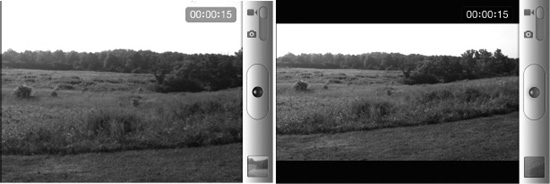
Figure 13–6. The video-recording screen shows the time elapsed while recording. Double-tap the screen to enter 16:9 aspect ratio.
TIP: If you are going to be using the recorded video in a movie or be viewing it on your TV, you might want to make sure you are recording in landscape mode. You can record in portrait mode, but portrait mode is a weird aspect ratio to view videos in.
Changing the Autofocus and Exposure
As with still images, you can set the autofocus and exposure of recorded video. You’ll see a white box with crosshairs quickly appear. The iPhone’s camera reads the exposure setting of the part of the image inside the box and adjusts the video’s exposure settings accordingly. When you tap any portion of the image, the camera will also autofocus on the part of the image.
Accessing Your Camera from the Lock Screen
An amazing new feature of iOS 5 is the ability to quickly access your camera from your iPhone’s lock screen. This feature eliminates precious time wasted from having to unlock your iPhone, then swipe to the Camera app, and the tap its icon to open it. Now you can simply access the camera from the lock screen and get that spontaneous shot.
To access your camera from the lock screen, simply double-press the physical home button on your iPhone. Doing so brings up audio playback controls on the lock screen and a shortened slider bar. As you can see in Figure 13–7 there’s also a camera icon next to the slider bar. Tap it to be immediately taken to your camera.
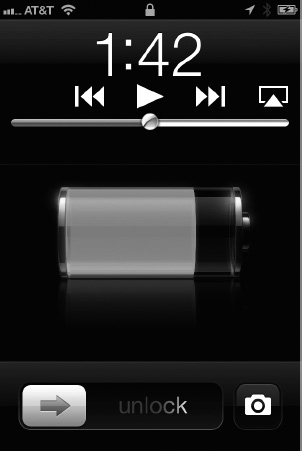
Figure 13–7. Accessing the camera from your iPhone’s lock screen
Viewing Your Camera Roll
To view all the photos you have taken and the videos you have recorded, tap the Camera Roll icon in the left of the control bar. The last image or video you recorded will appear on the screen. Tap the Camera Roll arrow to be taken to the Camera Roll (Figure 13–8).
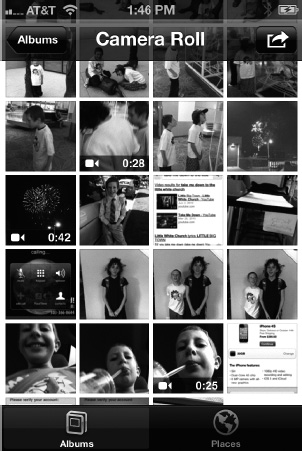
Figure 13–8. The Camera Roll contains all the photos and videos you have taken with the iPhone’s camera.
To view any individual photo or video, simply tap its thumbnail. Photo thumbnails appear as a picture square, while video thumbnails appear as squares with a single frame of the recording representing the video. A small camera icon with the length of the video in minutes and seconds overlays a video thumbnail’s image.
NOTE: When accessing the Camera from the lock screen, you’ll only be able to view Camera Roll items that you take from the lock screen. Other items in your Camera Roll remain hidden for privacy purposes.
Viewing Individual Photos
When in your Camera Roll, you will see thumbnails of the photos it contains (see Figure 13–8). To view a photo full-screen, tap the photo once. As you can see from Figure 13–9, you can view the photo in portrait or landscape mode.
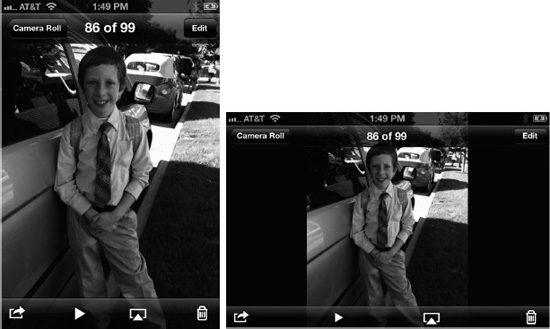
Figure 13–9. Viewing a photo in landscape and portrait modes
Once you display a photo full-screen, you have several ways to interact with it:
- Pinch to zoom into and out of the photo.
- Double-tap to zoom into the photo. Double-tap again to zoom out.
- When your image is displayed at the normal zoomed-out size, drag to the left or right to move to the previous or next image in the album. When zoomed into an image, dragging the photo pans across it.
While viewing individual photos, flip your iPhone onto its side to have your photo reorient itself. If the photo was shot using landscape orientation, it fits itself to the wider view. Tap any image once to bring up the image overlay, as shown in Figure 13–9. The image overlay features a menu bar at the top and bottom of the screen.
The image overlay menu bar at the top of the screen shows you the number of the selected image out of the total number of items in the Camera Roll and shows you the back button, labeled Camera Roll, to return to the album. You can tap the Done button to exit the Camera Roll and return to the Camera app.
At the bottom of the screen you’ll see the Share button (it looks like an arrow breaking free from a small box) and also a play button. The play button allows you to start a slideshow. Tapping the trash can icon will bring up a deletion confirmation menu. Tap the red Delete Photo button to delete the selected photo.
Viewing Videos
To view any video you have recorded, simply tap its thumbnail in the Camera Roll. The video will appear with a big play button in the center. Tap any area of the screen once to bring up the on-screen video controls (Figure 13–10).
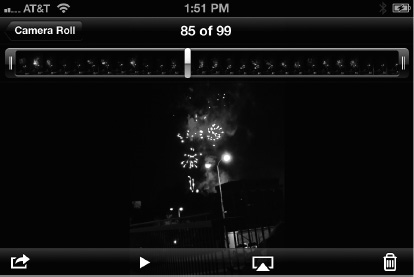
Figure 13–10. Displaying video from the Camera Roll. Tap once to bring up the on-screen menus.
Once you display a video full-screen, you have several ways to interact with it:
- Tap the video once to play it. Tap again to pause it.
- Scrub through the video by tapping and holding the silver drag bar in the scrubber bar. The scrub bar shows you segments of the video represented by thumbnails for those segments.
- Hold your finger on the scrub bar for a few seconds, and you’ll see the scrub bar stretch out. This gives you finer control over finding a specific spot in the video.
The video overlay menu bar at the top of the screen shows you the number of the selected video out of the total number of items in the Camera Roll and shows you the back button, labeled Camera Roll, to return to the main Camera Roll. You can tap the Done button to exit the Camera Roll and return to the Camera app.
At the bottom of the screen you’ll see the Share button and also a play button. The play button allows you to start playing the video. Tapping the trash can icon will bring up a deletion confirmation menu. Tap the red Delete Video button to delete the selected video.
The AirPlay button (the rectangle with the embedded triangle) appears only when there’s a valid AirPlay destination (typically an AppleTV) on your local network. To play the video out to AirPlay, tap the button and select the destination from the pop-up menu. Choose iPhone to restore the video to the built-in device screen.
Editing Your Video
Apple has included limited video-editing functionality in the Camera app. Video editing isn’t exactly the right word, though. Trimming is more accurate because you can shorten, or trim, the video at the front and end of the clip.
To trim a video, bring up the video menu overlays (see Figure 13–11). Next, grab the beginning of the scrub bar, and pull it to the right. This activates trim mode (Figure 13–14).
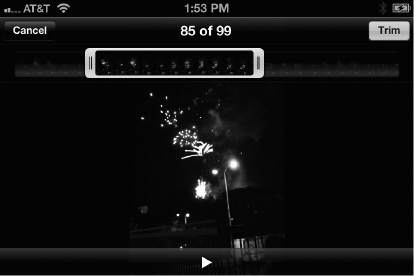
Figure 13–11. Video trim mode
In trim mode, you can drag the ends of the scrub bar, now outlined in yellow, toward the center. Dragging the ends shortens the clip at the beginning and the end.
Trimming is a great feature that allows you to highlight just the really good portions of your video clips. When you’ve adjusted your trim commands, tap the yellow Trim button to bring up a Trim pop-up menu (Figure 13–12).
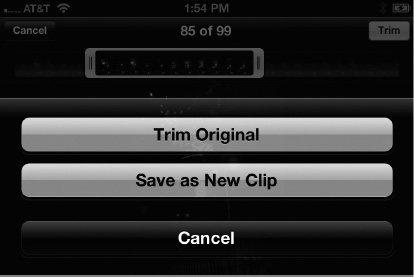
Figure 13–12. The Trim pop-up menu lets you trim the original or save the trim as a new clip.
The Trim command presents you with three options:
Trim Original: This replaces the original video recording. It will permanently delete the sections of video you have trimmed out.
Save as New Clip: This leaves your original video intact and creates a completely new video file of just the trim you specified.
Cancel: This closes the menu and returns to the clip with your trim points still set.
Remember that if you choose to keep the original clip, storage space on your iPhone can quickly fill up. A one-minute clip took up a whopping 120MB of space on our iPhone.
Sharing Your Video
While viewing any single video clip, you have several sharing options. To bring up the sharing menu, tap the Share button, which looks like an arrow breaking free from a small box (see Figure 13–10). You’ll be presented with a pop-up menu of sharing options (see Figure 13–13).

Figure 13–13. The video sharing options
Email Video: Selecting this command compresses the video clip as a QuickTime movie file. A new message window will appear with the movie clip attached to the body of the message.
Depending on the length of your video clip, you may get an error message that says “Video is Too Long.” If you see this, your iPhone will ask you whether you want to select a smaller clip from the video to e-mail. Tap OK, and you’ll enter trim mode, which will allow you to cut down the length of the clip.
Once you have trimmed your video, tap the yellow Email button above the scrub bar. A blank e-mail with the video in the body of the message should appear.
Message: Choose this option to send your video as an attachment for a message. Messages may be sent directly to other iMessage users using Apple’s internal infrastructure or sent to phone numbers using multimedia MMS text messaging. Charges may apply to both your and the recipients’ phone accounts.
Send to YouTube: Selecting this option will allow you to upload your video to YouTube right from your iPhone. On the screen that appears (Figure 13–14), enter a name and description for your video, select to upload it in standard- or high-definition, add tags, and finally select a YouTube category and then tap Publish. You must have a YouTube account to upload videos to YouTube.
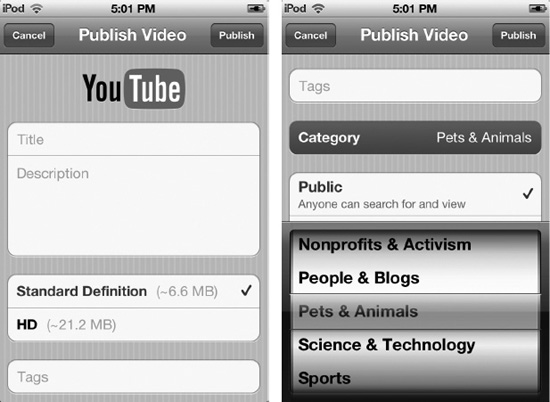
Figure 13–14. Publishing a video to YouTube
Uploading Images to Your Computer
Although it’s nice to e-mail and Tweet photos and upload videos to YouTube, most people primarily viewing their images on their computers. To get your pictures and videos off your iPhone and onto your computer, simply plug your iPhone into your computer via the USB-to-dock cable.
On a Windows computer, your photo software such as Picasa or Adobe Photoshop Albums should recognize the iPhone as just another camera and import the photos and videos as the application normally would. On a Mac, iPhoto will detect that your iPhone is connected and ask whether you want to import the videos and photos from the iPhone’s Camera Roll. You can also import media using OS X’s Image Capture utility. This utility (found in the Applications folder on your Mac) allows you to choose the default import application (see Figure 13–15).
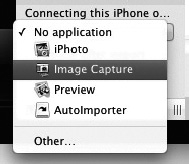
Figure 13–15. Choose your default iPhone import application in OS X’s Image Capture utility.
NOTE: iCloud’s new PhotoStream simplifies sharing your photos with all your devices. Snap them using your iPhone’s fantastic camera and view them on your iPad, your Mac, or your Windows PC.
Summary
The front and rear cameras add many nice features to your iPhone. The HD video-recording capabilities are amazing, and the still photography is breathtaking. Here are a few key tips for you to carry away with you:
- If you’re going on vacation, leave your bulky HD video camera at home. Your iPhone 4S lets you record great-quality video at 1080p. Just be sure to bring a laptop so you can dump your video off on its hard drive and make way for more video on your iPhone.
- The iPhone 4S’s updated video camera makes it the perfect companion for any aspiring photographer. You can catch that beautiful sunset over the ocean without having to lug along a point-and-shoot camera.
- Need a new profile picture for Facebook? The front camera on the iPhone makes it easy to take self-shots.
- You can zoom in while in still camera mode, but there is no zoom option while recording video.
- Each minute of 1080p video takes up a lot of space on your iPhone. Keep this in mind if you are going to be recording a lot of video because you’ll need a lot of free space on your iPhone. Consider using the other camera for casual video use.
- Apple has imposed a seemingly arbitrary limit on e-mailing videos. A video clip must be 54 seconds long or shorter in order for you to e-mail it. If it’s 55 seconds or longer, you’ll be asked to trim the clip before you e-mail it.
- If you are taking pictures or recording video within range of a Wi-Fi network, the iPhone’s Camera app will tag your photos and videos with geodata. Applications such as Apple’s iPhoto can then display your photos on a map.
